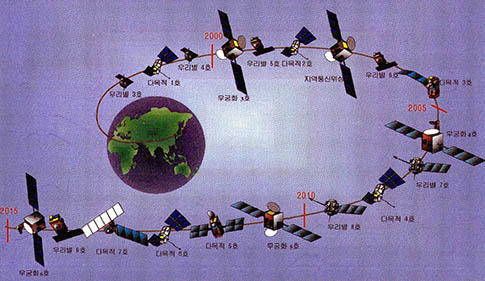천문학자의 동물원에서 가장 기묘한 것은 '블랙홀'일 것이다. 천문학자들은 이것이 정말로 존재하는지 여부를 밝히는 일에 전념하고 있는데, 최근 블랙홀이 존재함을 시사하는 몇 가지 증거가 발견되었다.
아다시피 어떤 별이 응집하여 구성 원자의 핵이 서로 접하게 될 수 있는데, 이러한 별은 '중성자별'이 된다. 이렇게 될 경우, 태양만한 크기의 별이 지름 8마일 정도의 작은 공(球)으로 축소되면서도 그 안의 모든 질량은 보존된다. 이러한 별은 중력장이 엄청나게 강해져서, 한찻숫가락의 양에 해당하는 물질은 1백만 t의 무게를 가지게 되며, 빛은 거의 빠져 나올 수 없는 정도가 된다.
중성자별은 겨우 1969년에 발견되었는데, 천문학자들은 이들의 존재를 확신하고 있다. 작은 것들은 아주 빨리 회전하는데 1초당 1번에서 1천번에 걸친 회전 속도를 가지며, 회전할 때마다 방출되는 고주파 펄스로 감지할수 있다. 광펄스를 방출하면서 빠르게 점멸하는 중성자별은 실제로 몇 개가 관측 된다.
그러나 만약 중성자별이 지나치게 크다면, 그것의 중력으로 원자핵들이 붕괴될 것이다. 그러면 별은 거의 크기가 없어지고, 중력장의 세기는 한없이 커지게 된다. 물체들은 이 응집된 별로 빨려 들어가고, 어떠한 것도 그 중력을 이겨내지 못하여 빠져 나올 수 없게 되며 따라서 그것은 마치 우주의 무한히 깊은 구멍과 같이 된다. 빛조차도 빠져 나올 수 없으며, 그래서 그것을 '블랙홀'이라고 부른다.
그러나 블랙홀이 실제로 존재하는가? 많은 은하들의 중심은 막대한 양의 에너지를 방출한다. 이것을 설명하는 가장 쉬운 방법은 큰 블랙홀이 은하의 중심에 존재한다고 가정하는 것이다. 심지어 우리의 은하수에도 중심에 큰 블랙홀이 존재하리라 믿어진다. 그러나 증거는 간접적일 뿐이며 따라서 전적으로 확실할 수는 없다.
블랙홀이라 믿어지는 것 중에서 우리와 가장 가까운 것은 '시그너스X-1'으로 불리우는 것인데 그것은 X-선의 원천이다. 시그너스X-1 근처에는 태양의 약 30배의 질량을 가진 거성이 관측되는데, 시그너스X-1과 함께 서로 주위를 공전하는 것과 같이 움직이고 있다. 천체 운동의 성질에 비추어 볼때, 시그너스X-1의 질량은 태양의 5~8배 정도록 추측된다. 아직까지도 시그너스X-1의 자리에서는 아무것도 관측되지 않고 있다. X-선만 감지되고 있는것이다.
시그너스X-1은 관측하기에는 너무 작고, 지구쪽으로 고주파 펄스를 방출하지 않는 중성자 별로 가정할 수 있다. 허나 중성자별은 태양의 3$\frac{1}{3}$배 이상의 질량을 가질 수 없기 때문에 이러한 가정은 옳지 못하다. 만일, 그 이상의 질량을 가질 때는, 자체의 중력장은 블랙홀로 응집되게 할 수 있을 만큼 강력할것이다. 따라서 시그너스X-1은 블랙홀임이 틀림없다.
이러한 결론이 상당히 결정적이긴 하지만, 회전쌍이 얼마나 떨어져 있느냐에 따라 바뀔 수 있는 문제이다. 만일 그것들이 우리의 생각보다 가까이 있다면, 거성과 X-선을 방출하는 물체간의 거리는 우리의 생각보다 가까울 것이다. 그러면 그들의 운동은 보다 적은 질량으로 생긴것일 것이다. 우리는 시그너스X-1이 우리로부터 1만 광년 떨어져있다고 생각하는데, 만일 3천 광년만 떨어져 있다면 어떻게 될까? 그런 경우에는 거성이 태양 질량의 약 10배 정도에 불과할 것이며, 시그너스X-1도 겨우 태양의 두배 정도가 될 것이고, 그것은 블랙홀이 아니라 중성자별일 것이다.
시그너스X-1으로부터 방출되는 X-선은 그것이 블랙홀일 경우에 가능할 것이다. 옆에있는 거성으로부터 떨어져 나온 물체들은 블랙홀로 끌어 당겨져 나선운동을 하면서 빨려들어 갈 것이며, 이때 X-선이 방출될 것이다. 그러나 X-선은 대상이 중성자별일 때도 방출될 것이다.
그러나 감마선은 그렇지 않다. '고에너지 천체 물리 관측체3'이라고 불리우는 인공위성은 시그너스X-1으로부터 방출되는 X-선과 감마선도 검출해 왔다. 감마선은 X-선과 유사하지만 파장이 더 짧으며, 따라서 X-선보다 더 큰 에너지를 가진다. 시그너스X-1에서 방충될 감마선은 그곳에서 방출된 X-선보다 1천배 이상의 에너지를 갖고 있다.
중성자별은 물질을 단단히 나선운동시켜 자동으로 X-선을 방출시킬 수 있을만큼 강력한 중력장을 갖고있다. 그러나 중력장이 감마선까지 방출시키지 못할만큼 물질을 단단히 나선운동하도록 강요하지는 못한다. 그러나 블랙홀은 한층 강한 중력을 갖고 있어 감마선을 생성할 수 있다.
올해 초, 제트추진연구소의 천문학자들은 관측하고 있는 물체를 이해할 수 있는 새로운 방법을 보고하였다.
감마선은 수십억도의 온도를 가진 가스가 존재하는 지름 3백마일 정도의 작은 부위에서 나오는 것으로 보인다. 이 정도의 온도에서는 가스는 전자―양성자 쌍을 생성시키고 이 쌍이 서로를 없애면서 감마선을 방출한다.
중성자별은 이러한 일을 해낼만큼 큰 에너지를 가지고 있지 않지만 블랙홀은 갖고있다. 이 새로운 자료는 시그너스X-1이 블랙홀이라는 것을 확신시켜 준다.
The most peculiar creature in the astronomers' zoo is the "black hole" and astronomers are laboring to determine whether it really exists. Recently, some evi-dence has appeared that seems to indicate that it does.
It is possible, you see, for a star to collapse so that its atomic nuclei come into contact, and it becomes a "neutron star." When that happens, a star the size of the sun collapses into a small sphere only eight miles across that still contains its entire mass. Its gravitational field then becomes monstrously intense; a teaspoon of its matter weighs a million tons. Light itself can barely escape from it.
Neutron stars were discovered only in 1969, and astronomers are certain they exist. The tiny stars turn rapidly, in periods that are anywhere from one turn per second to nearly 1,000 turns per second, and we can detect the radio pulses sent out with each turn. There are a few neutron stars we can actually see, as they send out pulses of light and blink rapidly on and off.
If a neutron star is too large, however, its gravity causes the atomic nuclei themselves to collapse. The star than shrinks down to virtually nothing and its gravitational intensity grows larger without limit. Things can fall into such a collapsed star, but nothing can battle its gravitation and emerge, so it's like an infinitely deep hole in space. Not even light get out, so it is a black hole.
But do black holes actually exist? The centers of many galaxies give off energetic radiation in huge quantities, and the easiest way of explaining that is to suppose there are enormous black holes there. Even our own galaxy seems to have a large black hole at its center. However, theevidence is indirect and not entirely convincing.
The nearest object to ourselves that may be a black bole is something called Cygnus X-1, which is a source of X-rays. Near the site of Cygnus X-1 a giant star is visible that is about 30 times as massive as our sun.
It seems to be moving in space as though it and Cygnus X-1 were revolving about each other. From the nature of the star's motion it would seem that Cygnus X-1 is from five to eight times the mass of the sun. Yet as the site of Cygnus X-1, nothing can be seen. All we can detect are X-rays.
We might suppose Cygnus X-1 is a neutron star, too small te see, and with its radio pulses not aimed in our direction. This can't be, though, because a neutron star can't be more than 3 1/3 times as massive as our sun.
If it is any more massive, its gravitational force would be large enough to make it collapse into a black hole. Cygnus X-1, therefore, must be a black hole.
That seems to be pretty conclusive, but it depends on how far from us that circling pair of objects might be. If they were closer than we think, then the giant star and the X-ray source would be nearer each other than we think. Their motion then could be brought about by smaller masses.
We think that Cygnus X-1 is 10,000 light-years away from us, but what if is were only 3,000 light-years away? In that case, the giant star would be only 10 times the mass of our sun, and Cygnus X-1 might be only two times the mass of our sun. It could then be a neutron star and not a black hole.
The X-rays that emerge from Cygnus X-1 would be expected if it were a black hole. Matter from its companion star would be pulled into the black hole and as the matter spirals down it would emit X-rays. However, X-rays also would be emitted if the object were a neutron star.
But not gamma rays. But a satellite called "High Energy Astrophysics Observatory 3," has been detecting X-rays coming from Cygnus X-1, also has been detecting gamma rays. Gamma rays are like X-rays but are made up of tiny waves even shorter than those of X-rays. Gamma rays, therefore, are the more energetic of the two. The gamma rays observed are up to 1,000 times as energetic as the X-rays that emerge from Cygnus X-1.
Neutron stars have gravitational fields strong enough to cause matter to spiral in tight turns that automatically emit X-rays, but the fields cannot force the matter to spiral so tightly that they will emit gamma rays. Black holes, however, with still greater graviational intensities, can produce gamma rays.
Astronomers at the Jet propulsion Laboratory in California, early this year, reported a new way of understanding looking at the matter. The gamma rays seem to be coming from a small region only about 300 miles across where must be gas at a temperature of serveral billion degrees. At such a temperatute this gas produces electron-positron pairs that annihilate each other and produce gamma rays.
Neutron stars just don't have the energy to do this, but black holes do. This new data, then, confirms that Cygnus X-1 is a black hole.
(c) 1988, Los Angeles Times Syndicate

















